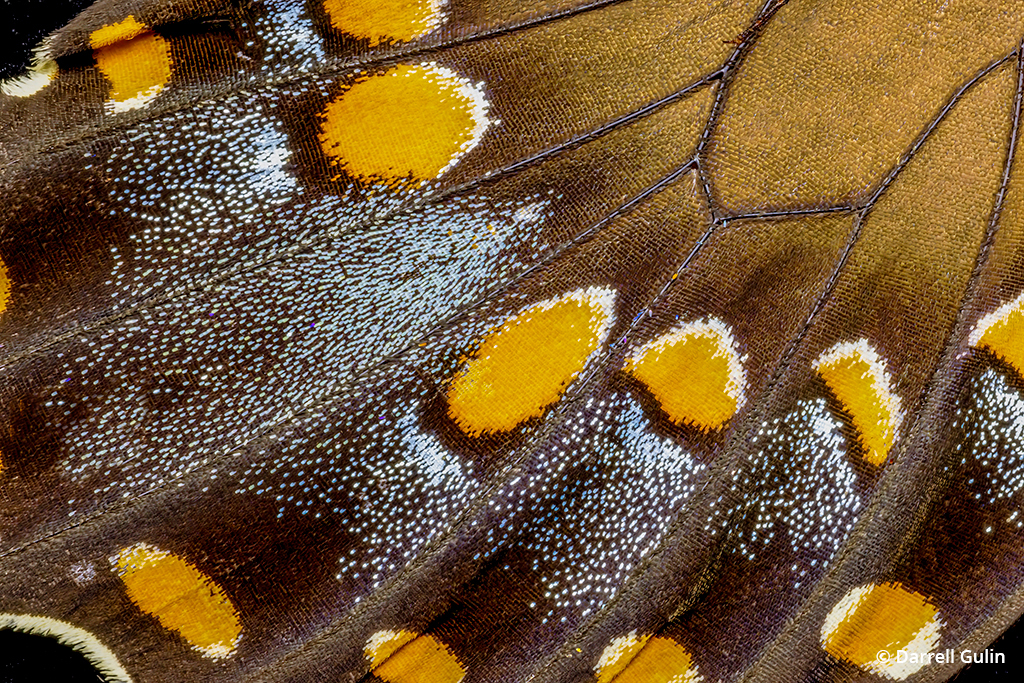
Butterfly Wing. Darrell Gulin saw the beauty in the intricate patterns and color of the scales comprising the wing of a spicebush swallowtail butterfly. It was easy to capture with a long exposure at 1.4x with the Canon RF100mm 2.8L Macro IS USM. Exposure: 2 sec., ƒ/32, ISO 1250.
In photography, the term macro is defined as a “life-size, 1x, 1:1 or larger” rendering of a subject on film or sensor. Any magnification less than 1:1 is considered “close-up” photography. A 100mm macro lens that captures images at 1x without accessories has been available to Canon users since 1979, beginning with the Macro FD 100mm f/4. A faster ƒ/2.8 upgrade designed for the EF mount came in 1990, a version with the ultrasonic motor (USM) was released in 2000, and image stabilization was added in 2009 with the EF 100mm f/2.8L Macro IS USM.
Canon’s 2021 version, a part of the mirrorless revolution, is itself revolutionary: The Canon RF100mm F2.8L Macro IS USM offers capabilities that have never before been available to macro photographers. The 100mm macro may be an old standby for nature photographers, but this newest lens is a big step forward in every sense of the word.
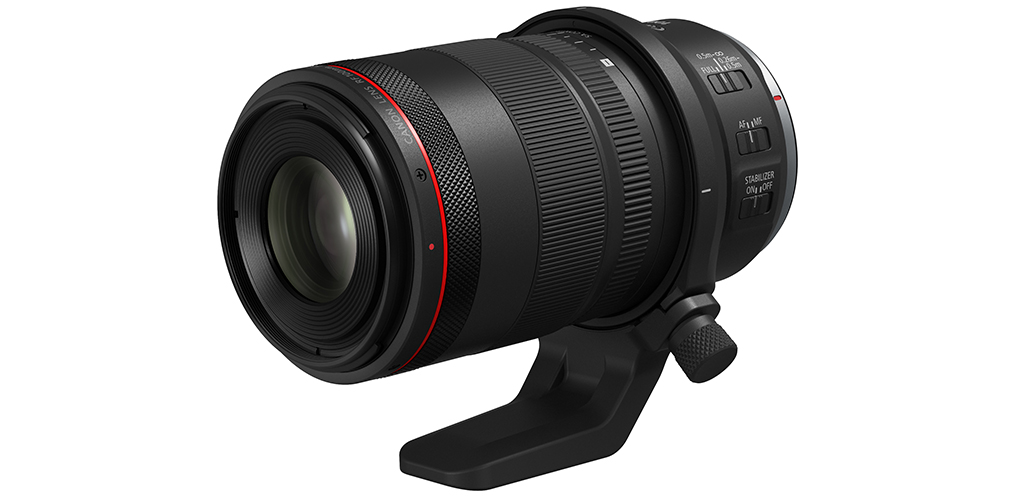
Canon RF100mm F2.8 L Macro IS USM
To give this new optic a true field test, Canon made the lens available to us for a joint project. We are both professional nature photographers with long-established relationships with Canon, but when faced with the same subject, we usually have different visions and approaches that yield distinctive results. This review will cover Canon’s newest macro lens from a broad range of photographic objectives.
The Essentials
The Canon RF100mm F2.8 L Macro IS USM has three important new features. First and foremost, its maximum magnification is 1.4x without any additional accessories, and yet it will focus to infinity. That’s a real game-changer. Hand-held work is supported by up to 8 stops of image stabilization when used with EOS R camera bodies having in-body image stabilization. Finally, the Canon RF100mm Macro offers a new capability, Spherical Aberration (SA) control, to expand creative options.
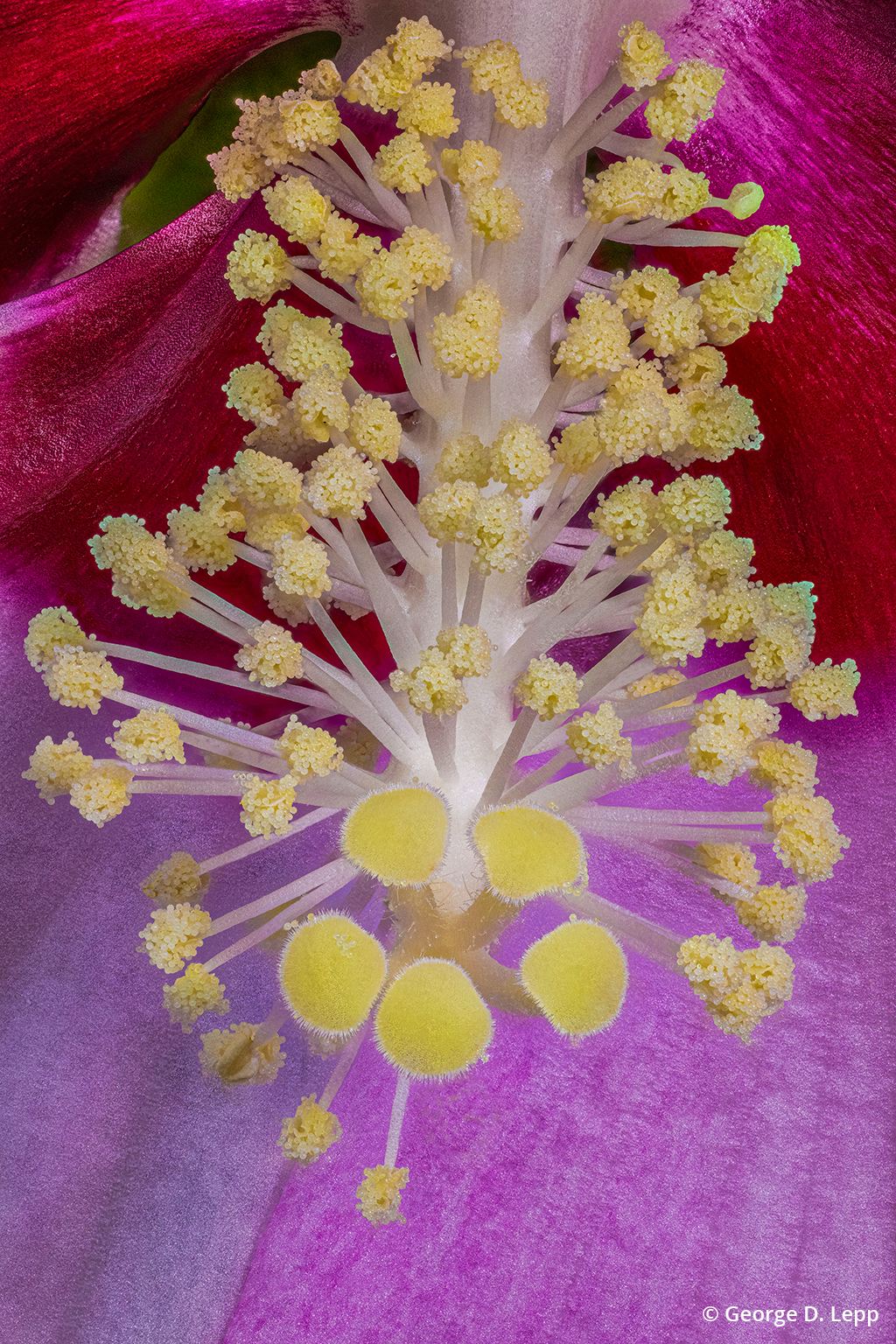
Big Detail. George D. Lepp’s obsession with revealing intricate details of nature not usually seen by the naked eye came into play in this garden photograph of a hibiscus blossom. The Canon EOS R5’s focus-bracketing capability and the RF100mm 2.8L Macro IS USM lens enabled the capture of the blossom’s complex structure at 1.4x with extraordinary detail. Ninety-four focus-stacked images composited post-capture in Zerene Stacker software. Exposure: 1/30 sec., ƒ/8, ISO 100, Outside available light with 2 additional LED photo lights.
We both used the Canon RF100mm Macro with the Canon EOS R5 mirrorless camera body, a lightweight, stable and agile combination when hand-held but also well adapted to tripod use, especially with the optional lens collar that enables quick and precise vertical-to-horizontal adjustments. The lens weighs approximately 1.6 pounds and accommodates 67mm filters. The lens aperture of ƒ/2.8 yields a bright and informative image to the viewfinder. This is maintained even at 1.4x, another advantage of the mirrorless EVF that compensates for the light loss at higher magnification (not the case with DSLRs).
.jwplayer { margin-bottom: 20px; margin-left: auto; margin-right: auto; }
In The Studio & The Field With The Canon RF100mm Macro
We each worked with the Canon RF100mm Macro lens to photograph a variety of subjects and situations, including studio setups for minerals, insects and floral specimens, and in the field for wildflowers to wild landscapes. We learned a lot about the new lens’s capabilities, and you can see how we individually applied some of these specific features and techniques in the images that accompany this article.
The Canon RF100mm Macro came to hand very nicely and has a quality feel. While it weighs slightly more than its immediate predecessor, the EF 100mm f/2.8L Macro IS USM for DSLRs, the added features more than make up for it. At 67mm, the filter size is the same as for EF 100mm macro lenses, so with a 67mm adapter, the RF100mm Macro works with previously issued accessories such as the Canon Macro Twin Lite and Macro Ring Lite. The optional tripod collar is strongly recommended for higher magnification work in the studio.
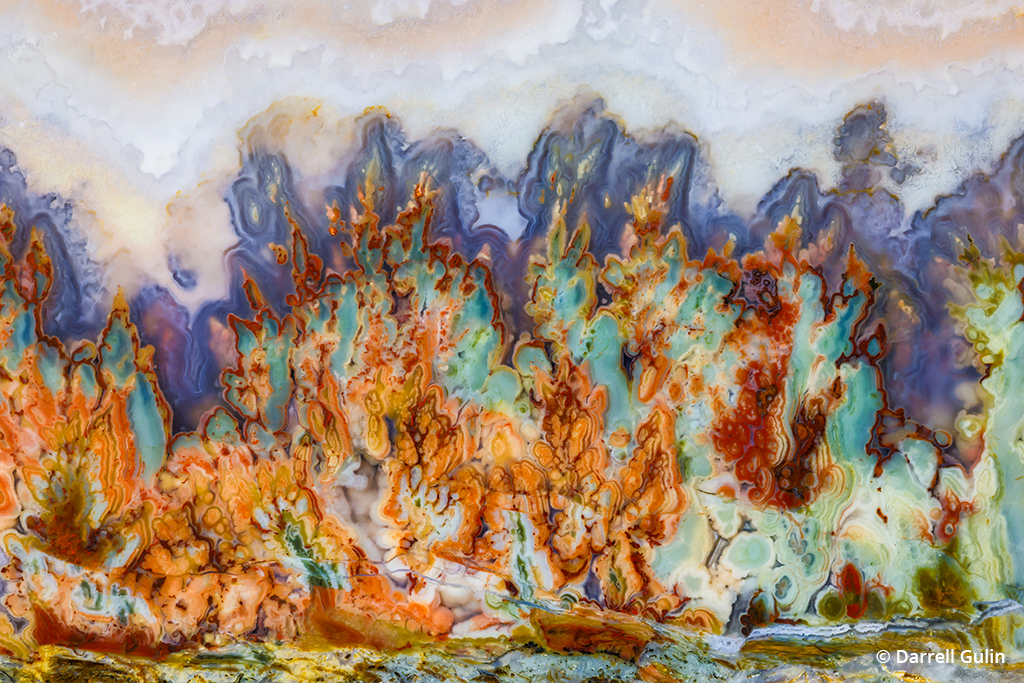
Set in Stone. Look closely at one of Gulin’s favorite macro subjects, the “prudent man” agate, and a miniature landscape comes to light. The delicate color and design are revealed with this capture. Exposure 0.7 sec., ƒ/16, ISO 800.
The Canon RF100mm Macro’s 1.4x capability is a significant upgrade for single-capture and focus-stacked macro work. The latter technique, which expands depth of field for critical detail, is greatly facilitated by in-camera focus bracketing available in Canon mirrorless bodies such as the EOS R5. Although the lens’s sharpness is slightly better than the already-stellar previous Canon macro lenses, it’s probably not that noticeable unless you pay particular attention to test charts. Nonetheless, this improved sharpness can be important when working at the higher magnification of 1.4x where details matter.
While there are not currently any Canon-made accessories available to take this lens past 1.4x, some third-party extension tubes designed for the RF lens mount will increase the magnification and even allow the addition of the RF1.4x or 2x extenders.
One of the Canon RF100mm Macro’s most innovative features is Spherical Aberration control, which allows the photographer to adjust the shape and character of background and foreground focus for creative results. A control ring on the lens barrel selects the different effects, which the photographer can preview in real time in the camera’s viewfinder. We found this feature to be particularly useful when working in the field but note that it works best when the lens is at its widest aperture. For maximum sharpness, the SA option can be disabled by a lock on the side of the lens.
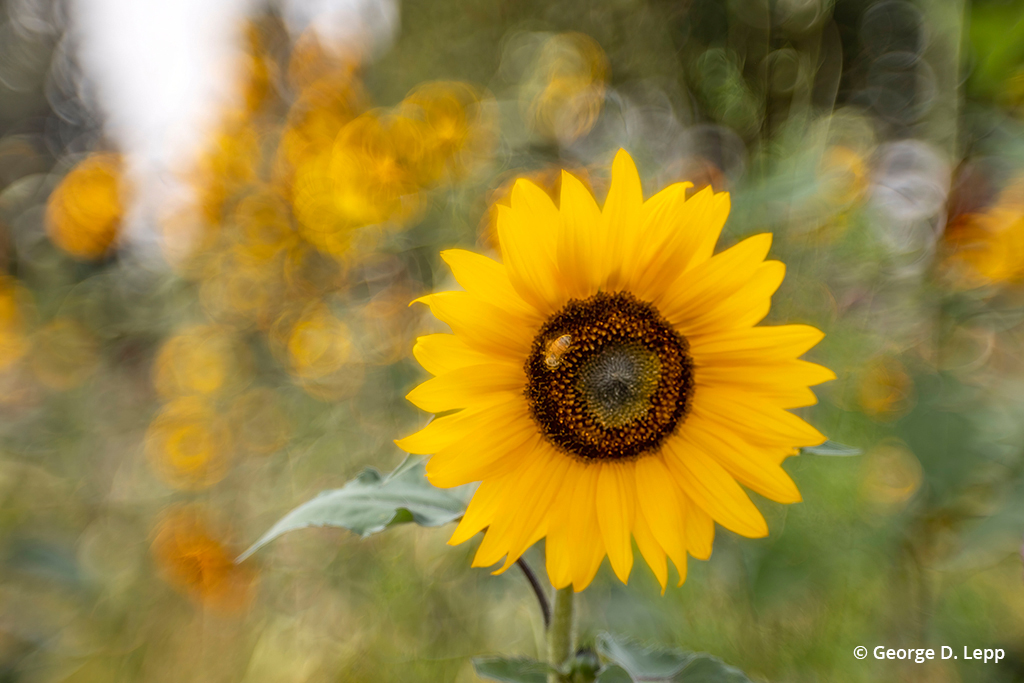
Big Bokeh. In a field of sunflowers, Lepp saw an opportunity to sharply showcase one bee-adorned blossom with a background of soft colors. Spherical Aberration control unique to the Canon RF100mm 2.8L Macro IS USM lens, coupled with the EOS R5’s electronic viewfinder, allowed him to view all the creative focus options before capturing the image. The AS setting on the RF100mm Macro was set to a +2 and the aperture was wide-open at ƒ/2.8. The bokeh in the background is greatly accentuated which works well for this flower rendition and is also excellent for portraits of people. To return to maximum sharpness the lens can be locked into the 0 setting for AS. Exposure: 1/750 sec., ƒ/2.8, ISO 100, SA +2.
For video, the lens has some very desirable qualities: Autofocus is very quiet, quick and precise, and that unique ability to focus from 1.4x to infinity truly enhances versatility.
Beyond Basic Macro
A macro lens is standard equipment for most nature photographers, but this lens goes well beyond the basics. If you are a nature photographer new to the Canon EOS R mirrorless system and RF lenses, the Canon RF100mm Macro should be near the top of your wish list for new glass. Whether your goal is precise detail working with a tripod in the studio or hand-held artistry in the field, this lens offers a range of magnification, focus and versatility that will do the job for you.
George D. Lepp is a member of the Canon Legends and field editor of Outdoor Photographer. See more of his work at GeorgeLeppImages.com.
Darrell Gulin is a Canon Explorer of Light. See more of his work at GulinPhoto.com.
<!–  By George D. Lepp and Darrell Gulin –>
By George D. Lepp and Darrell Gulin –>